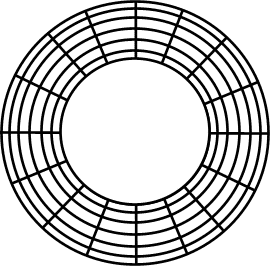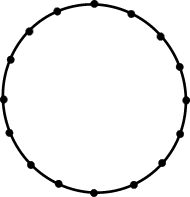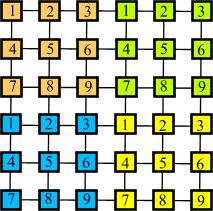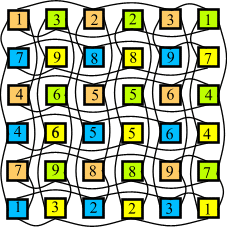Implementing automata in hardwareThe nature of today's digital hardwareAt the time of writing - in the year 2000 - most widely available computer hardware is essentially two dimensional.By this I mean that the technology involves etching circuitry onto flat, two-dimensional wafers of silicon. Sometimes more than one layer can be etched, but generally speaking, excursions into the third dimension do not get very far.
Implementing N-dimensional automata in M-dimensional substratesEfficiently implementing an N-dimensional cellular automata in hardware should prove simple provided that the hardware itself has N dimensions or higher.Today, in practice this means that it is possible to simulate relatively large one- and two-dimensional automata without significant loss of update speed. However, when three-dimensional automata are simulated, the distance between adjacent cells must rise as the size of the automata rises - as there are simply not enough dimensions to accomodate the desired connections. As more and more cells are added, adjacent cells in the automata must move to locations which become unboundedly distant from one another in the hardware.
Exploiting the substrate's potentialFor many applications, it is desirable for the automata to be of the same dimensionality as the hardware in order to best exploit the available connectivity.This is often true of applications which simulate universal computation, or perform other processing tasks, such as encryption or generating pseudo-random numbers. Use of (for example) a one-dimensional automata in a two-dimensional computing substrate can result in a waste of the available interconnect resources. Periodic boundary conditionsThere's an important exception to the idea that it is usually desirable to simulate an N-dimensional automata in N-dimensional hardware.If the automata has periodic boundary conditions, then you may get a performance increase by moving to N + 1 dimensions.
Embedding two-dimensional automata in three-dimensional substratesLastly, here's an image of a two-dimensional automata with periodic boundary conditions. It is represented as a torus embedded in a three dimensional space:
 It will be seen that even if extra dimensions are available, toroidal wrap-around still has some adverse effect on update speed. This can be seen by observing that the distance between nodes on the "outside" of the torus is larger than the corresponding distance on the inside. Assuming the cells on the "inside" are as closely packed as possible, those on the "outside" must be sub-optimally packed, with more distance between them than is strictly needed. While topological transformations may be able to reduce this effect to a small value, the delay can't be completely eliminated.
Summing upUse of periodic boundary conditions is not well in tune with the spirit of using cellular automata as a model for rapid computation in hardware.If you are trying to best exploit the available connectivity - by using an automata with the same dimensionality as your substrate - periodic boundary conditions are worth taking some effort to avoid.
|





